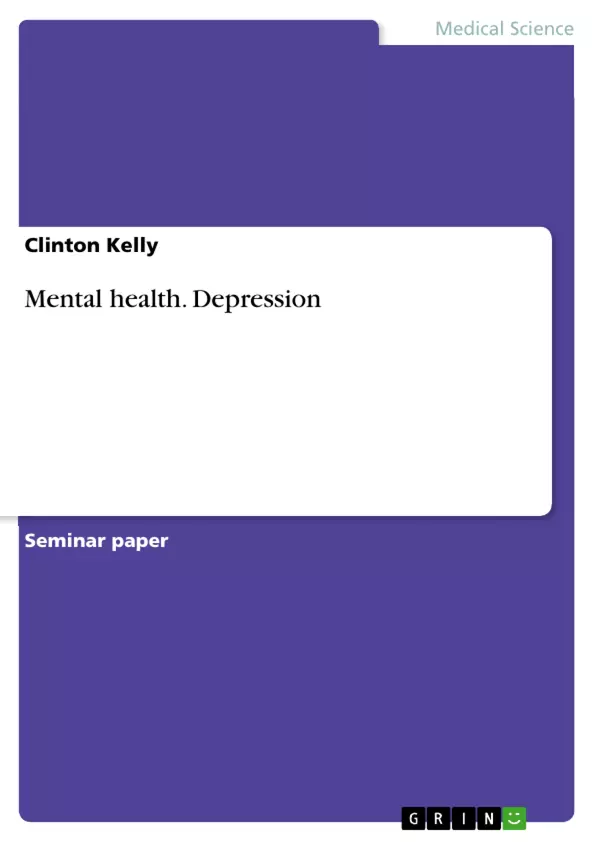According to Pooler (2009), depression is a form of disorder which is characterized by persistent feelings of worthlessness and sadness which makes someone lack the desire to engage in any formerly activity that is pleasurable. All mood disorders are characterized by a syndrome that include psychological like decreased concentration or somatic symptoms like insomnia. Anhedonia (depressed mood) is a prominent feature of this illness. Nevid (2009), adds that depression involves moods, body and thoughts hence cause pain for individual with the disorder and those who care about him or her. Mood disorders are classified into unipolar depressive disorders and bipolar disorders. The disorders are in different forms which include Major Depression disorder, dysthymic disorder and several others with different characteristics like postpartum depression, psychotic depression and seasonal affective disorder. Individuals suffering this illness have such symptoms like agitation, loss of interest; sleep disturbance, lack of concentration, low self-esteem, and a very low mood. Individuals under depression may ruminate over feelings of worthlessness, helplessness or self-hatred (Tsuang, Tohen, & Jone, 2011). They have poor concentration and memory and hence they might report multiple physical symptoms. Individual behavior is usually lethargic or agitated hence affecting family and friends. In most children, irritable mood is highly displayed unlike depressed mood. Due to lack of treatment or early recognition the illness is missed and delayed hence making it much worse. This is in low and middle income countries where access to healthcare is a major problem (Herrman, Maj, & Sartorius, 2009).
The point of prevalence in India is serious with mental disorders reaching 10-20 per 1000 of population. The provisions of health services are severely lacking where only about 20% of districts have implemented District Mental Health Program plan. Around 10% of individuals affected by mental disorders in India are receiving the right treatment facilitated by the huge disparity to access to health care facilities that are largely concentrated in urban areas (Goldberg, 2012). By 1999 the prevalence of India was 26.3% and 14,582 thousand DALY’s from depression. The current prevalence rate is estimated to be 15.1%. This is 3.66% of DALY’s due to all causes. In 2006 the suicide mortality rate was 10.5 per 100,000. The prevalence level is even higher on individuals who are most vulnerable
Inhaltsverzeichnis (Table of Contents)
- Introduction
- Public health agenda
Zielsetzung und Themenschwerpunkte (Objectives and Key Themes)
This text examines the challenges of mental health, specifically depression, in low and middle-income nations, using India as a case study. It aims to highlight the complexities and barriers surrounding treatment and care, emphasizing the need for greater attention and resources to address this growing issue.
- Prevalence and Impact of Depression in India
- Barriers to Mental Healthcare Access
- Insufficient Resources and Funding
- Cultural Stigma and Misconceptions
- The Role of Public Health Policy
Zusammenfassung der Kapitel (Chapter Summaries)
Introduction
This chapter discusses the prevalence of depression in India, highlighting the country's limited resources and inadequate mental health infrastructure. It emphasizes the lack of access to healthcare, particularly in rural areas, and the significant disparities in treatment availability. The chapter also examines the impact of socioeconomic factors on mental health, revealing that individuals in low-income groups are disproportionately affected.Public health agenda
This chapter focuses on the challenges of addressing mental health within a broader public health agenda, particularly in low and middle-income countries like India. It explores the competing priorities for limited resources, emphasizing the focus on communicable diseases and the struggle to adequately address mental health needs. The chapter discusses the inadequate funding and insufficient manpower dedicated to mental health care, highlighting the need for significant investment to improve the current situation.
Schlüsselwörter (Keywords)
This text explores the key issues surrounding mental health, particularly depression, in low and middle-income nations, focusing on the case of India. The text emphasizes the challenges of limited resources, inadequate healthcare infrastructure, cultural stigma, and insufficient public health policies dedicated to addressing this growing problem. It highlights the need for increased awareness, funding, and comprehensive mental health services to improve treatment and care for individuals suffering from depression.
- Quote paper
- Clinton Kelly (Author), 2013, Mental health. Depression, Munich, GRIN Verlag, https://www.grin.com/document/271703



